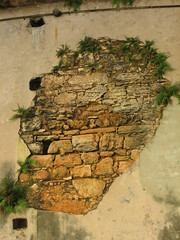It seems that everyjuan has his/hers mantrras in gardening. Orchids, heliconias, ferns, palms, lawns, hedges, gingers and palms to name a few. In Dave'sgarden.com, there is Palmbob, guess which is his. Once in a while he writes about cycads and related creatures.
I have about 20, however, weeds, preferably broad leaf and plants with weed behavior have been in the top lately. Gardeners who understand how they propagate, their preferences in general would be better at this, spending less energy, effort and chemicals to get rid of them or embracing and loving them as your humble servant.
that being written lets go
to Richard Mabey's
WEEDS
pages 82-83
There is an ironic footnote to this story of the shifts between the supersticion of the Dark Ages and the openminded curiosity of the
Age of reason. It is, in a literal sense, a cloistered story. Both monastery and university were physically characterized by walls. Wall enclosed their herb gardens and, symbolically, enclosed their knowledge, made it clear to the outside world where intellectual authority lay. Plants with the potential to become weeds are, of course, defined by their contempt of boundaries. What happended in monastic herb gardens was that some of the medicinal herbs took to growing in the walls. They used them as stepping stones into the outside world, and into a more popular conciousness.
The monasteries were thenselves institutions for traffic in weeds. Some, such as the Cluniac Order ( a branch of the Benedictines), had abbeys in the far south of France, and would have brought medicinal herbs over with them. Amongst were species that, like the weeds of agriculture, were natives of dry rocky places in the Mediterranean, and they found the dry stonework of the walls designed to keep them in was a congenial springboard for finding their way out.
Remnants of the walls of Bury St. Edmunds Abbey, where the Apuleius Platonicus Herbarium of 1120 was produced, still survive, and are adorned by weeds. Some are comparatively new (buddleia, for instance), showing that walls are also devices by which plants can get in. But some - feverfew (for headaches), greater celandine (for eye complaints) and wallflower (for ulcers and for helping 'the chops or rifts of the fundament') - might just be descendants of plants that grew in the Abbey physic garden 900 years ago. All are now common on the stonework and in waste places throughout Britain.
If the cultivated field provided a portal for weeds in the countryside, the boundary wall and the road were their gateways to the urban world. Whatever institutions human created to preserve their civilisation from the wild, weeds found ways of exploiting it
If the cultivated field provided a portal for weeds in the countryside, the boundary wall and the road were their gateways to the urban world. Whatever institutions human created to preserve their civilisation from the wild, weeds found ways of exploiting it
The more I read about weeds, the more tolerant I am with those I know, the ones I am getting to know...
That is that.
* from the Bible and a Joan Manuel Serrat song, not my coinnage
.


Good job! It's truly an amazing facts that there are so many species grow in these interesting places out of our focus but many of these are very important and useful for us by the support of medicine or lots of others. Thanks for make a precious consciousness about this ignorance matter.
ReplyDeletefiberglass chairs
I appreciate the visit and feedback. Thanks!
Delete